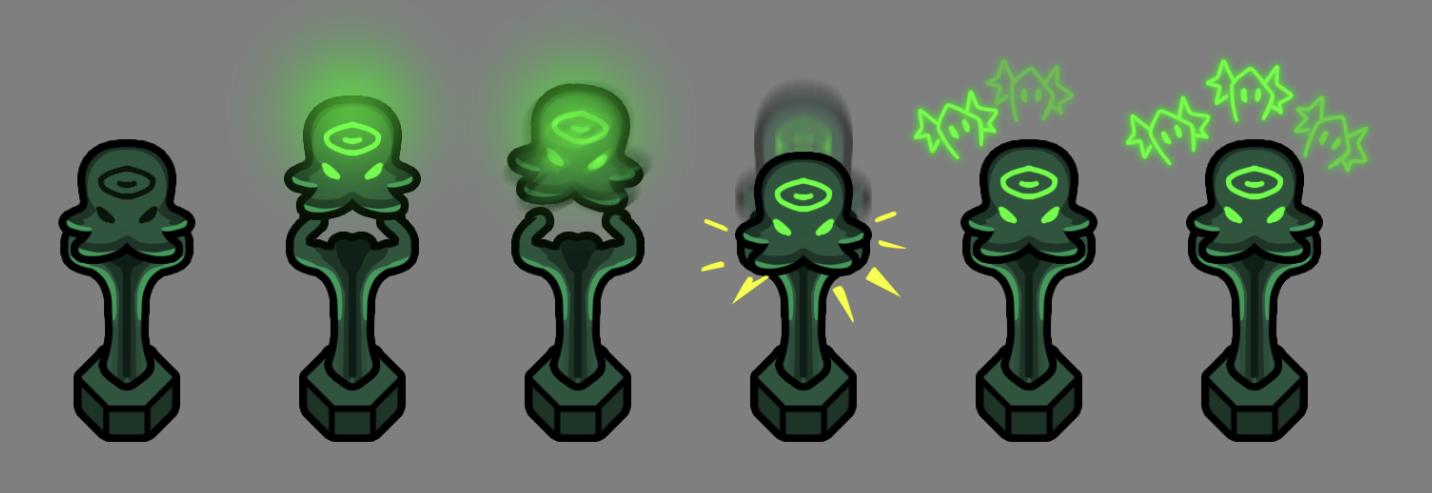
Game Design
Responsibilities
As a Game Designer for Ritual Night, I was responsible for the game’s level design, designing gameplay props and authoring the game’s lore and worldbuilding.
My work involved working across disciplines from game design, visual design and technical design to help build out mechanics and deliver a polished and exciting gameplay experience for a social deduction game.
Experience
OUTFOX GAMES - Sept 2022 - Jan 2025
Level Design
Narrative Design
Gameplay Design
Unity C#
Figma
Miro
Tools
Map Design
When I started work on Cthulhu’s Mansion, I was given the task to make changes to its layout based on playtest feedback while fulfilling the goals of creating an introductory level that honed in on the game’s thematics and core gameplay loop.
Initial layout that we had for Cthulhu’s Mansion prior to my involvement in layout adjustments and environment art direction.
Latest iteration of the Spook Fest Carnival map.
My early work on the mansion was to create unique rooms, designing smaller spaces that emphasizes hide and seek elements and atmosphere.
Spook Fest Carnival
I was tasked with authoring Ritual Night’s 2nd map from start to completion. This gave me the opportunity to learn the full process of game level production, which included work on:
Pre-production research and concept. Establishing visual references and narrative connections to Ritual Night’s core plot and themes.
Layout design and iteration, ideating new spaces and unique mechanics to pitch and prototype in engine.
Conducting playtest sessions to find correlation between intended strategies and adjusting based on player feedback.
With creating the 2nd map for Ritual Night, it was important that I maintained consistency to the game’s core feel while also offering fresh spaces for players to explore and use for strategy. The Carnival map was chosen to emphasize Ritual Night’s casual party theme and use the unique carnival rides to offer players interesting ways to navigate space and create new chokepoints for its hide-and-seek gameplay beats.
Cthulhu’s Mansion
I contributed towards the production of the Cthulhu’s Mansion level after prior first pass work of another designer. I ensured that the map met the design goals of being an introductory map for players while honing in on the game’s visual and narrative direction.
My work on Cthulhu’s Mansion included
Designing layout and theming of unique rooms with respect to narrative and facilitate hide-and-seek gameplay.
Implement gameplay mechanics such as the Jail, objective encounter locations and design vision blockers.
Lead the environment art direction to create a consistent atmosphere and mood for Cthulhu’s Mansion.
I iterated on the design throughout stages of development while looking to these pillars.
Eventually I was given the responsibility of the map’s environmental deails and art. This is when I fully pushed to hone in on the Mansion’s interior space and build a sense of character with each unique room and corner of the map, emphasizing the mysterious yet playful tone of Ritual Night. Being in charge of both layout and environment art, I was able to connect layout and visual design to have more compelling spaces. One of my favorite areas in the map is the lower left wing, establishing a sense of depth and verticality while creating unique visuals for the Observatory and Dungeon.
Gameplay Design
Rune Tablet Machine
I was also given the responsibility for designing various interactable gameplay props. This involved taking concept ideas from sketches to fully implemented assets in-engine.
The Rune Machine is a gameplay prop that promotes cooperation by requiring two players to flip 2 switches at the same time in order to activate the prop. It was initially intended for players to find the Rune Stone Fragments first and place it on the machine. However it had to be cut due to certain constraints.
Detector Totem
The Detector Totem is a prop that when activated, releases a pulse that detects disguised players within its radius, displaying how many are disguised.
Balloon Box
The Balloon Box inflates after a set time after activating. Players caught near its blast will get pushed back and the balloon also blocks vision and movement.
Cardboard Box
The Cardboard Box is a simple prop that can be toggled open/closed so that players can hide.
Narrative Design
Cipher wheel to be used for narrative clues found in-game.
Setting the Stage
During our production of Ritual Night, I was given the task of providing narrative context for the game’s world and characters. It was important for us to have some narrative background in order to create gameplay features and map content that players can connect to. This responsibility involved:
Providing a narrative bible document for how and why the rituals take place in the game’s world, with respect to our reference material (H.P. Lovecraft).
Provide enough narrative base to create new content from, such as new characters and factions that fit into the context of Monsters vs. Humans
Newspaper clipping found in game.
Creating Intrigue and Mystery
As a social deduction game, mystery and intrigue are part of the game’s world. It was important for us to lean into this by creating a world where the Rituals are kept in secret — giving the players a sense that their activities in game are shrouded in mystery.
This resulted in various art assets and narrative beats that hint towards the elusive nature of the rituals and that they are something to be investigated by the Humans of this world.
Madman’s sketch of Cthulhu






















